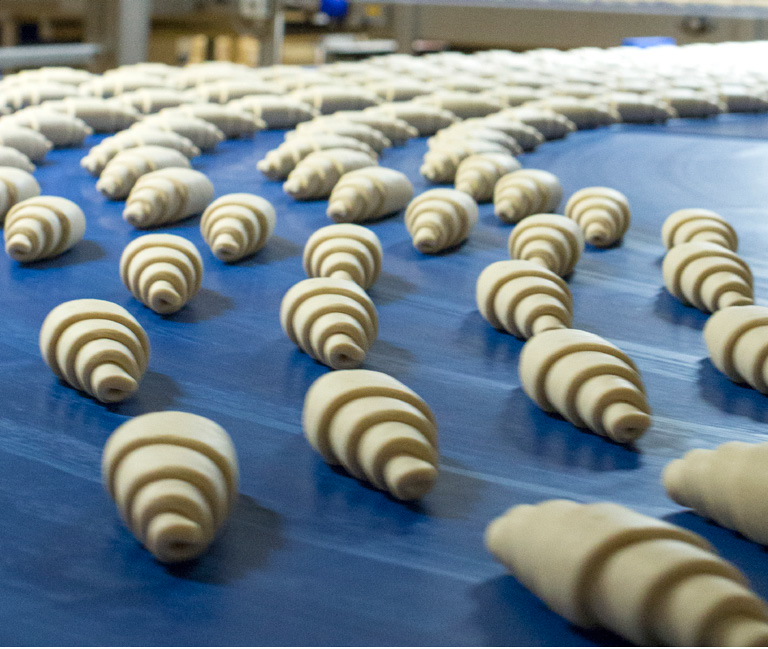
LONG SHELF-LIFE PRODUCTION
PRODUCTION WITH LONG SHELF-LIFE
Laminated products like croissants and puff pastries are gaining popularity worldwide. Each region of the world has its own laminated products and, consequently, unique characteristics. In some parts of the world, especially in the Middle East and Asia, there is a demand for products with a long shelf-life. This is why croissants and pastries with a long shelf-life have been developed. Croissant production lines were among the very first bakery production lines produced by Rademaker, and we are proud to be a global leader in this field. With four decades of experience, Rademaker can produce long shelf-life production solutions that meet the requirements of our customers.
Impression of a Turnkey long shelf-life production installation
Impression of a Turnkey long shelf-life production installation.
In long shelf-life production lines, the first important question is how long the desired shelf-life should be. Shelf-life can range from 7 days to 6 months. This shelf-life not only determines the recipe but also the dough development procedure. The way the products are cooled and packaged also greatly affects the shelf-life of the product.
Rademaker Technology for long shelf-life
According to Rademaker's technology for long shelf-life, four factors determine the quality and shelf-life:
1. RECIPE
The recipe for long shelf-life products is unique. Long-lasting softness is created by using mother dough and a rich recipe with margarine, sugar, eggs, glucose syrup, and a special mix of enzymes. The enzyme mix can be used in combination with a bread improver to contribute to tolerance and volume.
The combination of these ingredients, in the specific composition, will reduce the amount of free water in the dough (aW).
In hot, humid countries, or in the case of desired long shelf-life, calcium propionate (cp) is used as a preservative, up to a maximum of 0.3% of the flour weight.
Another crucial aspect for the shelf-life of these products is the choice of filling. It is important to use fillings that are balanced with the crumb of the baked product; if the filling is too hygroscopic, it will attract all the water from the crumb. If the filling releases water, the result will be a soaked, spotted crumb with dehydrated filling.
The final aspect is the choice between margarine (or shortening, fat, etc.) or butter. Butter is much more sensitive to spoilage than vegetable fats.
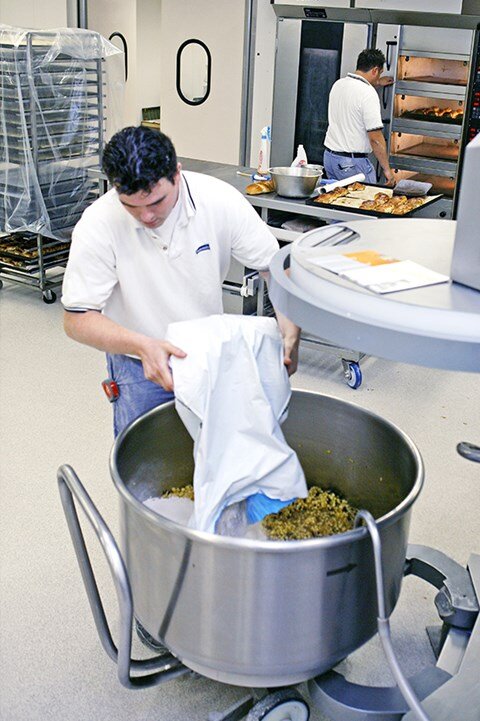
2. PROCESS / PROCEDURE
Long shelf-life croissants are produced with very long fermentation times. This differs from the process for 'normal' croissants. The long fermentation times arise from the use of mother dough (also called levains, brews, preferments, sourdough, etc.) in combination with a very low amount of free water and the very high amount of fat and sugar in the dough. Maximum flavor development and sometimes the use of preservatives like calcium propionate also contribute to these long fermentation times. However, the mother dough process contributes most to this.
The mother dough process starts with a small amount of culture or yeast strain. This culture arises spontaneously through air fermentation or by purchasing a yeast strain. Then, this yeast strain is enlarged by adding flour, water, and setting the correct temperature. This enlargement can be done in different fermentation steps. Whether one, two, or three fermentation steps are chosen depends on the recipe cost, desired quality, pH, production equipment, and dough processing. Important is the development of the yeast strain called 'Saccharomyces Exiguous'. This yeast strain will lower the acidity of the dough and provides a natural preservative.
To enlarge the yeast strain and keep its characteristics lively, there are three basic methods:
- 1: Buy ready-made yeast strain from an ingredient supplier.
- 2: One-time purchase
A certain amount of yeast strain/culture can be used as a starter for the next day. Whether the yeast strain/culture of the mother dough remains stable and performs the same daily depends on the conditions in the bakery. - 3. Repeated purchases.
Every day a new batch is started for croissant production. This method may be slightly more expensive, but the predictability of the production process, especially the final proofing time, is much more reliable.
pH
Mother dough is necessary to, in addition to flavor and crumb softness development, lower the pH of the dough. This creates natural preservatives (various types of lactic acid, citric acid, etc.). During the fermentation of the mother dough, the pH will drop to levels of < 4. After mixing and final proofing, the pH can reach 4.5 to 5.
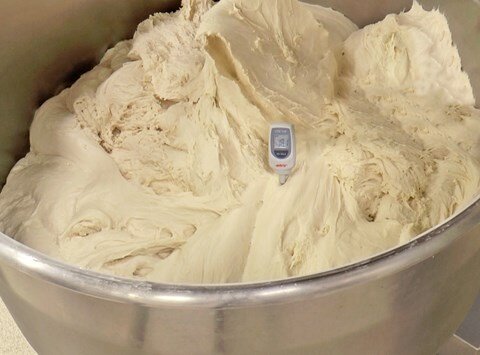
3. DOUGH FORMING EQUIPMENT
Rademaker Croissant and Pastry production lines are capable of efficiently producing long shelf-life products. Capacities start at 800 kg up to over 2,000 kg per hour, resulting in production from 12,000 pieces per hour up to 70,000 pieces per hour. The capacity depends on the size and weight of the product.
The Rademaker Laminator delivers the correct laminated dough sheet. This dough sheet is fed to the Rademaker Croissant or Pastry production line. Thanks to the Low Stress Sheeter, it is possible to process dough that requires the long fermentation times needed for long shelf-life croissants.
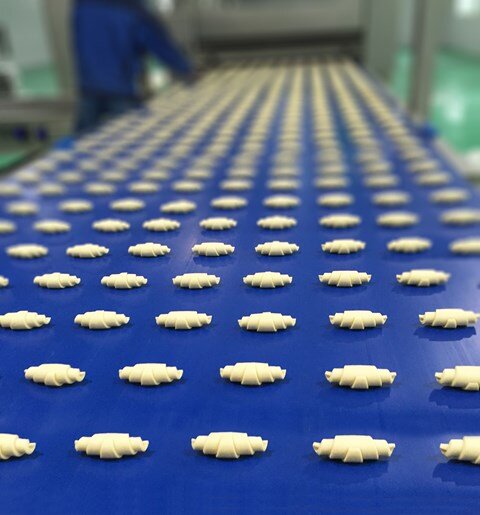
4. Processing: Proofing, Baking, Packaging
For long shelf-life croissants, the final proofing is very long. This is due to the use of mother dough, the rich recipe, the use of preservatives, and the very limited amount of water. Depending on the recipe, we have seen final proofing times from 180 minutes to bakeries with over 300 minutes.
To prevent the product from drying out and to retain the maximum moisture inside, the product must be baked with limited convection and maximum radiation and conduction. The baking time depends strongly on the size of the product. For example, for a 65-gram product, the baking time is about 11 minutes.
A very important aspect that also determines the shelf-life and quality of the product is the final step in the production process: packaging. Assuming that the products are packaged in flow-pack (horizontal) or transwrap (vertical) packages, there is the possibility to extend the shelf-life by using gas flushing: a mixture of nitrogen 40% - 0% and carbon dioxide 60% - 100%. This procedure requires special equipment and special film to be used. Spraying the surface of the product with alcohol before packaging (or even better, a mixture of alcohol, sugar, and aroma) is also a way to extend the shelf life. It keeps the crumb of the croissant soft and minimizes the presence of bacteria as much as possible.
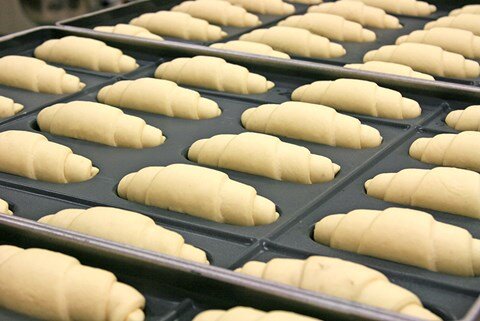
Summary of conservation techniques for long shelf-life products:
There are basically three ways to preserve the product:
- In the dough. By lowering the pH through long fermentation/mother dough technology or by adding calcium propionate. In addition, the filling may contain preservatives that affect the crumb of the croissant.
- Special treatment of the crust.
- All around the croissant by gas flushing during the packaging process.
The expertise in technology for long shelf-life products is carefully applied in Rademaker's production solutions. As a global leader in industrial bakery production lines, you can be sure that your Rademaker production line will deliver the taste, texture, shape, and capacity that you and your customers expect.

